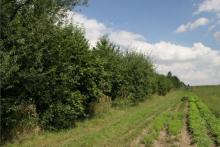Diverse use of multi-use Hedges for sustainable production, to reduce erosion and to increase regional added value
Multi-use hedges offer additional benefits and added value beyond the normal function of windbreak hedges due to their multifunctionality. In addition to the usual hedge plants, multi-use hedges also contain more (wild) fruit, nut trees and shrubs, dye plants, precious woods or even fast-growing woody plants or grasses that can be used for energy production.
Hedges: Wind braking and positive effects on the microclimate
Hedges reduce wind speed up to a distance of 25 times the hedge height on the downwind side and up to 5 times on the upwind side. They protect the soil from wind erosion and ensure that fertile topsoil is preserved. By reducing air movement, they have a positive effect on the microclimate and the local water balance, which is becoming increasingly important in view of climate change.
Hedges provide insects, birds, and mammals with a source of food, hiding places and nesting opportunities, thereby encouraging beneficial insects. All these factors have a positive effect on the agricultural yield of fields protected by hedges. The yield-enhancing effect extends to a distance of 10 times the hedge height and yields up to a 10 percent increase.
Multi-use hedges are created in such a way that they bring additional benefits to the farm beyond these positive effects. A typical example of such an additional bonus is the use of (wild) fruit and nuts from the multi-use hedge for the production of local or regional specialties such as jams or premium brandies, or the use of native wild herbs from the hedge environment.
In the lee of the hedge, a zone of distinctively dry warm microclimate is created in the immediate vicinity, which can be used for the production of drought-loving healing and aromatic herbs. It would also be possible to plant a hedge with trees or shrubs inoculated with mushroom mycelium for the production of truffles, porcini mushrooms & Co.
Of course, the wood from the hedge can also simply be used for energy, as logs by removing individual trunks or by creating a two-part hedge as a short rotation area of which one row is used alternately, then the other rows. Miscanthus could also be created as a hedge. In the same way, a special hedge could be oriented towards the production of precious wood for carpentry, woodturning or carving.
Multi-use hedges, in combination with agricultural land, are an agroforestry system suitable for Central European environmental and economic conditions.
The increase in farm value added achieved through utilization compensates for the costs of establishing and maintaining the hedges and the loss of profit due to the elimination of agricultural use on the hedge area.
The concept of the multi-use hedge and the term "multi-use hedge" were developed by Dr. Wilfried Hartl and Dr. Eva Erhart, Bio Forschung Austria. In 2003, farmer Franz Binder in Untermallebarn planted the first multi-use hedges on his own fields according to these ideas with the support of the Lower Austrian Agricultural District Authority.
Downloads:
The project "multi-use hedges" is supported by the Lower Austrian Landscape Fund.
![]()
07.10.2025
CatchHedge - Potenziale von Hecken im Zeichen des Klimawandels
more ...16.+17.09.2025
32nd Conference of the Danube Region
more ...12.09.2025
Grundlagen der professionellen Bio-Mandel-Produktion
more ...10.09.2025
Agroforst u. Marktgärtnerei, Symbiose
more ...25.06.2025
Feldtag - StripTill im Bio-Mais im Trockengebiet
more ...25.06.2025
Seminar: Wildbienen- und Nützlingsförderung im Biolandbau
more ...24.06.2025
BOKU Green Plate Forum 3.0
more ...24.06.2025
Die Maulbeere - Kultur, Produktion u.Verwendung
more ...17.06.2025
Frühjahrstagung Österr. Gesellschaft für Agrar- und Umweltrecht (ÖGAUR)
more ...13.06.2025
Seminar: Artenvielfalt in Ackerbauregionen fördern
more ...03.06.2025
Seminar: Keine Angst vor der Ackerdistel
more ...03.06.2025
Agroforstsysteme: Anbau-Modelle der Zukunft
more ...20.05.2025
IDM-Generalversammlung 2025
more ...15.05.2025
Seminar: Unkräuter/Beikräuter erkennen und als Zeigerpflanzen nutzen
more ...13.+14.05.2025
Bodenforum Österreich - Frühjahrstreffen
more ...04.05.2025
Tageskurs: Perma-Veggies - Mehrjähriges Gemüse und essbare Stauden
more ...03.05.2025
Waldgärten-Exkursion
more ...08.04.2025
Agroforst: Traditionelle Systeme von Land- und Forstnutzung verbinden
more ...26.+27.03.2025
Tagung "Weniger Bodenversiegelung, mehr Zukunft - wie gelingt das?"
more ...20.+21.03.2025
Vitiforst - wie integriere ich Gehölze in meinen Weingarten?
more ...



